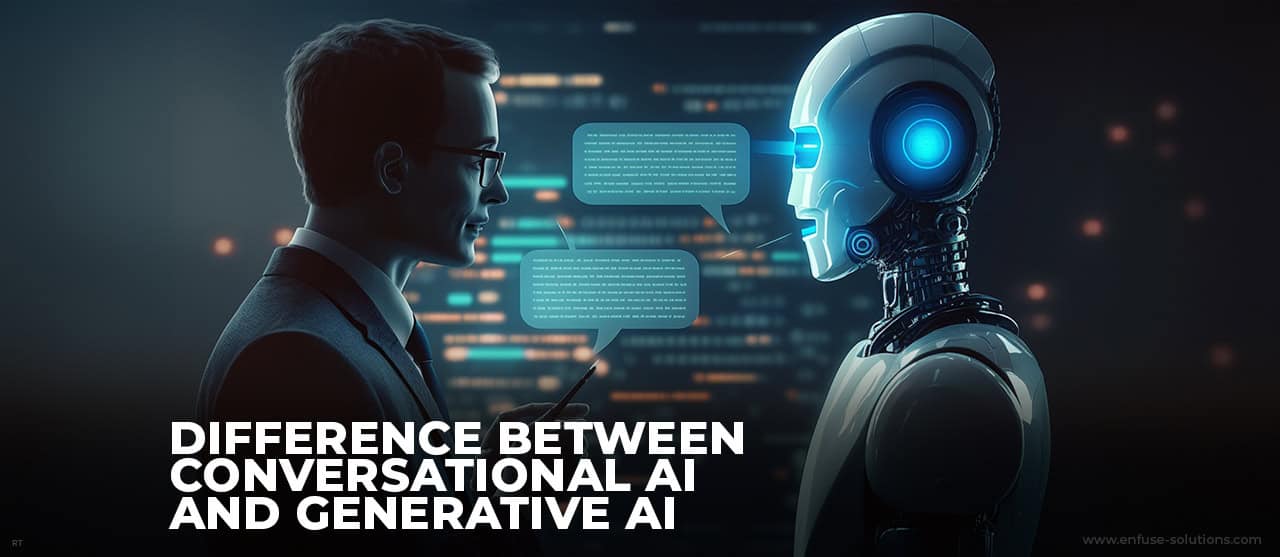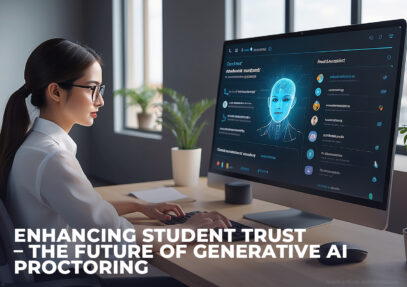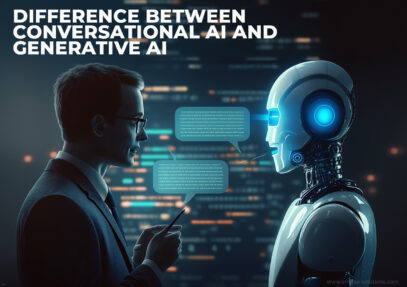
The artificial intelligence (AI) landscape is evolving rapidly, introducing new paradigms reshaping industries, and enhancing user experiences. The AI market experienced significant expansion, achieving a valuation of around $103 billion in 2023. Forecasts indicate an exponential increase at a Compound Annual Growth Rate (CAGR) of 19.1%.
Two prominent branches of AI that have garnered significant attention are Conversational AI and Generative AI. While they share some underlying technologies, their applications, methodologies, and impacts differ markedly. Understanding their differences is crucial for businesses and technologists looking to leverage these technologies effectively.
This blog delves into these differences, backed by the latest statistics and reports, to provide a comprehensive understanding of both artificial intelligence domains.
What Is Conversational AI?
Conversational AI refers to technologies that enable machines to understand, process, and respond to human language in a natural, conversational manner. It encompasses various AI-driven tools and platforms like chatbots, virtual assistants, and voice-enabled applications. Key components of conversational AI include natural language processing (NLP), natural language understanding (NLU), and natural language generation (NLG).
Key Features Of Conversational AI
1. Natural Language Understanding (NLU): Comprehends and interprets user inputs, identifying intent and context.
2. Context Management: Maintains the conversation context, ensuring coherent and relevant responses.
3. Dialogue Management: Manages the flow of conversation, including handling multiple turns and complex queries.
Applications Of Conversational AI
1. Customer Support: Chatbots and virtual assistants manage customer inquiries by delivering swift and effective responses.
2. Healthcare: AI-driven virtual assistants help in patient interaction, appointment scheduling, and preliminary diagnosis.
3. eCommerce: Enhances customer experiences through personalized product recommendations and seamless shopping assistance.
4. Finance: Banks and financial institutions leverage AI for customer service, detecting fraud, and providing financial guidance.
Statistics And Trends
The conversational AI market is booming, with a CAGR of 22.6% from 2021 to 2028, according to Grand View Research. By 2024, the global conversational AI market is expected to reach $13.9 billion, driven by advancements in AI technologies and increasing adoption across various sectors.
1. Integration With CRM Systems: Companies are incorporating Conversational AI into their Customer Relationship Management (CRM) systems to enhance and simplify customer interactions.
2. Voice Assistants: The use of voice assistants like Amazon Alexa and Google Assistant is growing, with over 4.2 billion devices in use worldwide as of 2023.
3. Enhanced Multilingual Support: Conversational AI systems are becoming more adept at supporting multiple languages, catering to a global audience.
What Is Generative AI?
Generative AI refers to algorithms and models that can create new content, such as text, images, music, or code, that resembles human-created content. This branch of AI is powered by advanced machine learning models like Generative Adversarial Networks (GANs) and Variational Autoencoders (VAEs).
Key Features Of Generative AI
1. Content Creation: Produces creative outputs, including writing articles, generating art, and composing music.
2. Data Synthesis: Generates synthetic data for training other AI models, enhancing their performance without extensive real-world data collection.
3. Personalization: Creates personalized content based on user preferences and behavior.
Applications Of Generative AI
1. Content Creation: AI models like GPT-4 generate human-like text for articles, stories, and even coding.
2. Art And Design: Creates unique artwork, logos, and design elements.
3. Music Composition: Composes original music tracks, offering new tools for musicians and producers.
4. Game Development: Generates characters, levels, and storylines in video games.
Statistics And Trends
The generative AI market is experiencing rapid growth, with a projected CAGR of 34.9% from 2020 to 2027, as reported by Allied Market Research. The market is projected to grow to $126.5 billion by 2030, fueled by rising demand for AI-generated content and ongoing advancements in AI technologies.
1. AI-Generated Art: Platforms like DALL-E 2 are pushing the boundaries of AI-generated art, allowing users to create intricate images from textual descriptions.
2. Content Creation Tools: Tools like Jasper and Copy.ai are revolutionizing content marketing by assisting in writing high-quality articles and copy.
3. Video And Audio Synthesis: AI is expanding its use in generating realistic video and audio content, with applications in entertainment, education, and beyond.
Fundamental Contrasts Between Conversational AI And Generative AI
-
Purpose And Functionality
1. Conversational AI: Focuses on understanding and responding to human language to facilitate interaction.
2. Generative AI: Primarily focuses on creating new content that mimics human creativity.
-
Core Technologies
1. Conversational AI: Utilizes NLP, NLU, and NLG to understand and generate human language.
2. Generative AI: Employs models like GANs, VAEs, and autoregressive models (e.g., GPT-4) to generate new content.
-
User Interaction
1. Conversational AI: Engages in real-time interaction with users, requiring continuous input and feedback.
2. Generative AI: Often operates independently of real-time user interaction, generating content based on pre-defined parameters or prompts.
-
Implementation And Use Cases
1. Conversational AI: Implemented in customer service platforms, virtual assistants, and interactive chatbots for various industries.
2. Generative AI: Used in creative industries for content generation, data augmentation, simulation, and synthetic data generation for training AI models.
Challenges And Ethical Considerations
-
Conversational AI
1. Bias in Responses: AI models can inadvertently perpetuate biases present in the training data, leading to biased or inappropriate responses.
2. Privacy Concerns: Handling sensitive user data requires robust security measures to protect user privacy and data integrity.
3. Contextual Understanding: Ensuring the AI understands the context accurately to provide relevant and accurate responses remains a challenge.
-
Generative AI
1. Content Authenticity: Distinguishing AI-generated content from human-created content can be difficult, raising concerns about authenticity and misinformation.
2. Copyright Issues: Generative AI can create content that may infringe on existing copyrights, posing legal challenges.
3. Ethical Use: Ensuring that generative AI is used ethically and responsibly to prevent misuse, such as generating deepfakes or malicious content.
Future Prospects
-
Conversational AI
The outlook for conversational AI is optimistic, thanks to ongoing progress in machine learning and natural language processing. The integration of emotional intelligence and empathy into AI models is a growing trend, aiming to make interactions more human-like and personalized. Moreover, enhancing multilingual capabilities will allow conversational AI to serve a global audience more efficiently.
-
Generative AI
Generative AI is poised to transform creative fields by providing innovative tools for artists, writers, and designers. Advancements in more refined and manageable AI models will improve the quality and variety of content created by AI. Moreover, ethical frameworks and guidelines will be crucial to ensure the responsible use of generative AI technologies.
Conclusion
Conversational AI and Generative AI represent two distinct yet complementary branches of artificial intelligence, each with unique applications, technologies, and challenges. While conversational AI focuses on enhancing human-machine interactions through natural language understanding and generation, generative AI aims to push the boundaries of creativity by generating new content.
As AI continues to evolve, both fields will play pivotal roles in shaping the future of technology and society. Understanding these differences is crucial for businesses, developers, and users to harness the full potential of AI and navigate the ethical and practical considerations that come with it. By staying informed about the latest trends and advancements, we can leverage AI to drive innovation, enhance experiences, and create a more connected and creative world.
At EnFuse Solutions, we specialize in AI and ML enablement, offering tailored solutions that harness the strengths of both Conversational and Generative AI to drive innovation and efficiency in your business.

















Comment